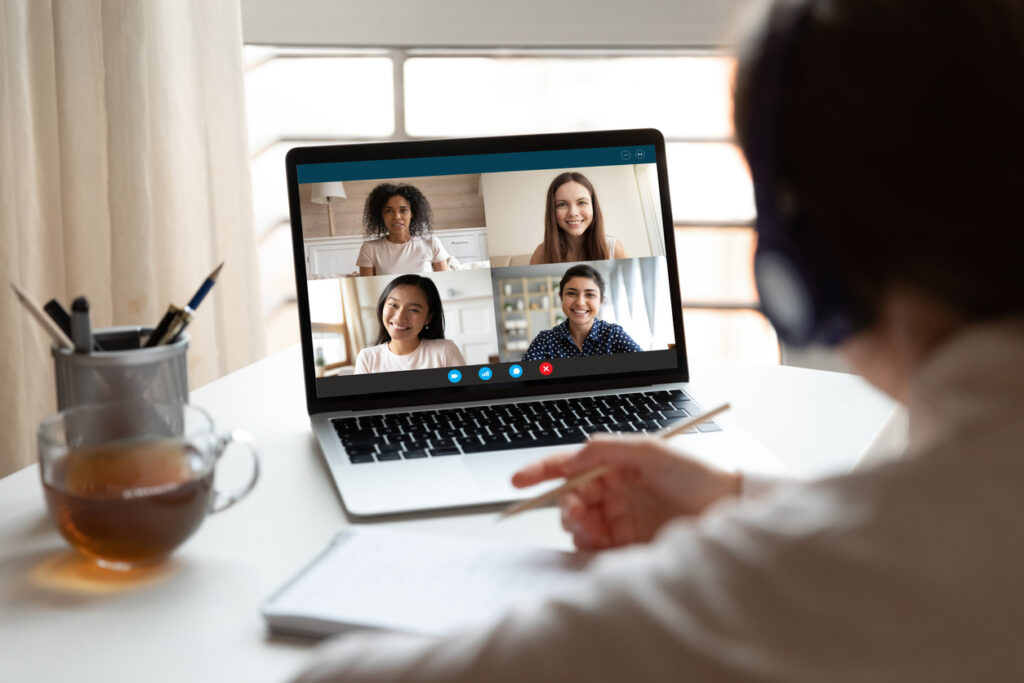The Covid-19 pandemic has presented learning and development professionals with the urgent challenge of optimising virtual facilitation. Looking to the near future, we will see hundreds of thousands of people moving into roles and sectors that are completely new to them. That’s why it’s critical that organisations prepare for bringing new recruits up to speed remotely. It’s more important than ever before because we face a decade when up to 90% of UK employees, for example, will have to reskill as a result of changes in the economy.
A sprint mindset can help improve your training programmes by embedding an agile, inclusive approach.
Where do companies start, however, if they’re trying to make a success of virtual facilitation? The methodology you use is a good first consideration. It’s fair to say that it can make or break your overall strategy. The right methodology will help you:
- Define
- Discover
- Design
- Develop
- Deliver
This year, we’ve found a sprint mindset can help improve your training programmes by embedding an agile, inclusive approach that can be a key differentiator for success. Iteration can be an accelerator for achieving the outcomes you set at the start. It’s vital that you always come back to those key outcomes to make sure you’re delivering against the organisation’s objectives.
Enhancing the experience
A development phase can be used to launch low-fidelity yet fit-for-purpose training by working in sprints to enhance experiences, with validation exercises and simulations aligned to performance, behaviours and learning needs.
We have found that open documents, chat channels and video can help build momentum. High performance delivery hinges on intelligent workforce management. A skills matrix and utilisation document ensures that the right people, with the right abilities, are in place. Progressing virtual training involves the delegate, the facilitator and the programme content. We start by completing an analysis of what we believe are the knowledge, skills and attitudes that are key for success. We then share these aims with the delegate and together we build something to read, something to do and something to watch so that they have confidence to apply the key learning and behaviours to enhance performance. As a ‘faculty’ we have driven very high utilisation by matching opportunities with facilitators based on skills.
The structure of virtual training sessions certainly became a bigger topic in 2020. Short, impactful interventions are effective when so many people are working remotely. You should also consider cognitive bias when trying to make sessions as enjoyable as possible. Take the peak–end rule, for example, which impacts how people remember past events. You should be aiming to deliver intense positive moments during sessions and making sure they end on a high note so that learners both enjoy training and find it easier to remember the knowledge they’ve gained.
Creative design solutions, like gamification and split screen technology should be used to engage, test, recognise and reward learners. Supported by the fundamentals of virtual learning, modules can definitely be enhanced by the way you develop and manage self-directed and group exercises. We ensure we are striking the right balance with these activities and are always sharing learning and ideas from virtual breakout rooms when the whole group comes back together. This year, we also found that through self-help guides and the astute use of videos, gamification and social media we were able to save an average of four hours training time per colleague while sustaining a quality experience and achieving performance outputs.
Keep ‘thinking human’
Through these extraordinary times, it’s been more important than ever that we ‘think human’ and communicate with colleagues so they get the most out of their training. This starts with the first onboarding call, typically the Friday before a new recruit joins. It’s the opportunity to make sure they have all the right kit and to answer any questions they have.
Learning and development teams and trainers should let people know that they understand the challenges everyone is facing when working from home – someone else’s phone is ringing, the dog’s barking – there will be moments of frustration, and laughter too. Colleagues will appreciate knowing that they’re encouraged to use the chat or turn off their camera when they need to. Taking the time to talk all this through and establish human contacts between facilitators and colleagues helps to alleviate the main sources of stress and make your training programmes more successful.
Of course, it’s just as important to invest in those doing the training as those receiving it. Create the right environment for observations and make facilitators feel valued, for example, by supporting their career progression and helping them achieve their goals.
At Webhelp this year, we invested time to quickly skill our front-line trainers to deliver virtually while maintaining a personal approach. Tips for training tools and opportunities to share best practice via virtual departmental meetings were set up for facilitators, to highlight learning points and successes.
Make the most of digital tools
You will most likely have cleared the communication hurdles by putting pre-tested platforms in place, such as Zoom, Microsoft Teams or Adobe, but it’s important to consider which platform has the most suitable functionality for a particular session, and it’s also important to not be dependent on just one solution. Always have a plan B.
Being agile might mean using mobile apps and tools to make it easier for your learners to complete their training. Today, digital tools are invaluable for enhancing the learning experience and measuring success. These include apps and tools such as Kahoot! for reporting, Hey Taco! to recognise and reward learners, and Menti to sprinkle in knowledge validations via games and quizzes.
No matter where your people are now or in the months to come, mastering virtual facilitation will ensure that you can support the organisation’s objectives and take everyone on the journey of discovery and recovery that lies ahead.
Interested in this topic? Read Learning technology: neuroscientific insights to make virtual learning work better.
The Covid-19 pandemic has presented learning and development professionals with the urgent challenge of optimising virtual facilitation. Looking to the near future, we will see hundreds of thousands of people moving into roles and sectors that are completely new to them. That’s why it’s critical that organisations prepare for bringing new recruits up to speed remotely. It’s more important than ever before because we face a decade when up to 90% of UK employees, for example, will have to reskill as a result of changes in the economy.
A sprint mindset can help improve your training programmes by embedding an agile, inclusive approach.
Where do companies start, however, if they’re trying to make a success of virtual facilitation? The methodology you use is a good first consideration. It’s fair to say that it can make or break your overall strategy. The right methodology will help you:
- Define
- Discover
- Design
- Develop
- Deliver
This year, we’ve found a sprint mindset can help improve your training programmes by embedding an agile, inclusive approach that can be a key differentiator for success. Iteration can be an accelerator for achieving the outcomes you set at the start. It’s vital that you always come back to those key outcomes to make sure you’re delivering against the organisation’s objectives.
Enhancing the experience
A development phase can be used to launch low-fidelity yet fit-for-purpose training by working in sprints to enhance experiences, with validation exercises and simulations aligned to performance, behaviours and learning needs.
We have found that open documents, chat channels and video can help build momentum. High performance delivery hinges on intelligent workforce management. A skills matrix and utilisation document ensures that the right people, with the right abilities, are in place. Progressing virtual training involves the delegate, the facilitator and the programme content. We start by completing an analysis of what we believe are the knowledge, skills and attitudes that are key for success. We then share these aims with the delegate and together we build something to read, something to do and something to watch so that they have confidence to apply the key learning and behaviours to enhance performance. As a ‘faculty’ we have driven very high utilisation by matching opportunities with facilitators based on skills.
The structure of virtual training sessions certainly became a bigger topic in 2020. Short, impactful interventions are effective when so many people are working remotely. You should also consider cognitive bias when trying to make sessions as enjoyable as possible. Take the peak–end rule, for example, which impacts how people remember past events. You should be aiming to deliver intense positive moments during sessions and making sure they end on a high note so that learners both enjoy training and find it easier to remember the knowledge they’ve gained.
Creative design solutions, like gamification and split screen technology should be used to engage, test, recognise and reward learners. Supported by the fundamentals of virtual learning, modules can definitely be enhanced by the way you develop and manage self-directed and group exercises. We ensure we are striking the right balance with these activities and are always sharing learning and ideas from virtual breakout rooms when the whole group comes back together. This year, we also found that through self-help guides and the astute use of videos, gamification and social media we were able to save an average of four hours training time per colleague while sustaining a quality experience and achieving performance outputs.
Keep ‘thinking human’
Through these extraordinary times, it’s been more important than ever that we ‘think human’ and communicate with colleagues so they get the most out of their training. This starts with the first onboarding call, typically the Friday before a new recruit joins. It’s the opportunity to make sure they have all the right kit and to answer any questions they have.
Learning and development teams and trainers should let people know that they understand the challenges everyone is facing when working from home – someone else’s phone is ringing, the dog’s barking – there will be moments of frustration, and laughter too. Colleagues will appreciate knowing that they’re encouraged to use the chat or turn off their camera when they need to. Taking the time to talk all this through and establish human contacts between facilitators and colleagues helps to alleviate the main sources of stress and make your training programmes more successful.
Of course, it’s just as important to invest in those doing the training as those receiving it. Create the right environment for observations and make facilitators feel valued, for example, by supporting their career progression and helping them achieve their goals.
At Webhelp this year, we invested time to quickly skill our front-line trainers to deliver virtually while maintaining a personal approach. Tips for training tools and opportunities to share best practice via virtual departmental meetings were set up for facilitators, to highlight learning points and successes.
Make the most of digital tools
You will most likely have cleared the communication hurdles by putting pre-tested platforms in place, such as Zoom, Microsoft Teams or Adobe, but it’s important to consider which platform has the most suitable functionality for a particular session, and it’s also important to not be dependent on just one solution. Always have a plan B.
Being agile might mean using mobile apps and tools to make it easier for your learners to complete their training. Today, digital tools are invaluable for enhancing the learning experience and measuring success. These include apps and tools such as Kahoot! for reporting, Hey Taco! to recognise and reward learners, and Menti to sprinkle in knowledge validations via games and quizzes.
No matter where your people are now or in the months to come, mastering virtual facilitation will ensure that you can support the organisation’s objectives and take everyone on the journey of discovery and recovery that lies ahead.
Interested in this topic? Read Learning technology: neuroscientific insights to make virtual learning work better.








